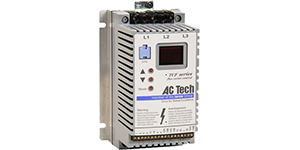Simulation Made Real With The TCF's Bi-Directional Control
Lenze Americas 12th Dec 2022
 Simulation Made Real With The TCF's Bi-Directional Control
Simulation Made Real With The TCF's Bi-Directional ControlThe Phenix Design Group, a Florida-based motion simulator manufacturer has made a name for itself as a general contractor in simulation projects. Phenix offers full simulation services including requirement analysis, conceptual design, program & technical management, installation, training and product 'reality' checks.

According to Phenix President Ron Handy, precisely controlling the motion in a simulator means incorporating the right inverter (Variable Frequency Drive) into the design of electrically actuated motion to ensure the best performance over a wide speed range. Some of the drives we tested simply didn't have the right 'feel' throughout the motion range, explains Handy. At low speeds, AC drives can feel mushy and not realistic for the application and some servo drives can feel 'stiff'.
Phenix's specific requirements for this project included off-the-shelf availability, small size and quick installation. With the Lenze AC Tech TCF inverter, Phenix got more than they asked for. The TCF inverter gives Phenix the crucial advantage of bi-directional control of their simulator using a bi-polar reference. The bi-polar reference input on the TCF allows the speed and the rotation direction of the drive to be controlled by one analog signal,(-10 to +10 VDC).
In drives without this feature, a 0 to +10 VDC analog signal would be used to control speed, while a separate digital input would have to be used to select forward or reverse direction. Being able to control direction and speed with one -10 to +10 VDC signal simplifies the control system. By using the TCF, when the signal is positive (from 0 to +10 VDC), the drive will operate in the forward direction. When the signal is negative (from 0 to -10 VDC), the drive will operate in the reverse direction. In both cases the motor speed will be proportional to the signal level (0 VDC is center of scale, -5 VDC is half speed reverse, +10 VDC is full speed forward, etc).
"There were two objectives behind our choice of a particular kind of inverter", explains Handy, "reducing product cost, and ensuring long-term reliability." In order to get the required level of performance for their simulators, Phenix may have had to rely on more expensive servo drives. "The value we're getting with the TCF is hard to argue with," summarizes Handy.
TCF Benefits
• Bi-Directional Control (Bipolar Reference)
• Micro-Size
• Seamless Integration Into System
• Reliable, Repeatable, Rugged Performance
• Outstanding Value
• Product Availability
• Global Support
12th Dec 2022


